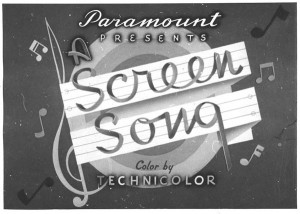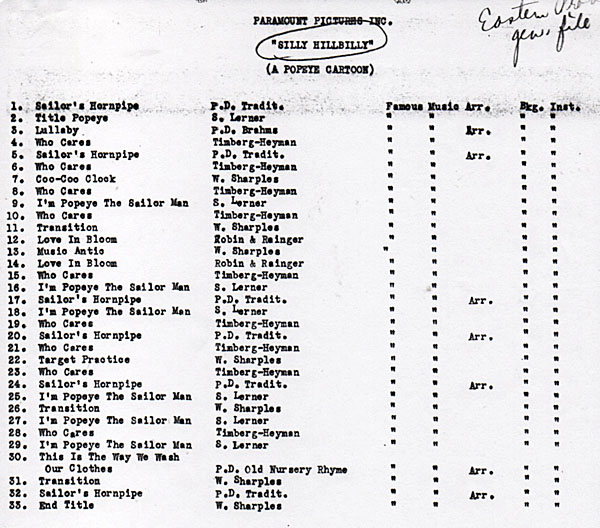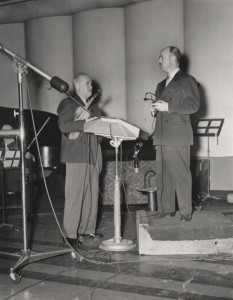 While Walt Disney and company were busy raiding the Great Latin-American Song Book. . . While Carl Stalling and Scott Bradley were also raiding the catalogues of the music publishers owned by their respective employers. . .
While Walt Disney and company were busy raiding the Great Latin-American Song Book. . . While Carl Stalling and Scott Bradley were also raiding the catalogues of the music publishers owned by their respective employers. . .
And while Darrell Calker was haunting the jazz clubs of Hollywood, looking for talent to contribute to the Walter Lantz “Swing Symphonies” shorts. . .
Paramount Pictures was busy seeing that all was well with their latest acquisition: the former Max Fleischer cartoon plant, now re-named “Famous Studios”,
With the studio (and most of its employees) re-located to New York after their five-year sojourn in Miami, things were changing in all aspects of the cartoons–including the music.
It must have seemed easier for Paramount execs to control the Famous Studios staff now that they were back in the Apple.
For one thing, Winston Sharples had a larger orchestra with which to work. Many of the Miami productions–especially in the later years of the Fleischer studio, and in the earlier Famous Studio product–feature the music of a scrappy-sounding orchestra. From the sound of it, the group could not be more than around twelve pieces.
They may have been the best cats that the Miami local could deliver. But there were so may more fine players in Local 802, and Sharples got to use a number of them.
There seems to have been more use of Famous Music copyrights in the all-color packages put out every year by Famous. Sometimes, the songs–or their titles–would be used as gag material. Thus “Sunday, Monday and Always”, a song introduced by Bing Crosby in Dixie (1943) winds up as gag fodder for both Popeye’s The Island Fling (1945) and Little Audrey’s Butterscotch And Soda (1948).

This cue sheet from the Popeye cartoon “Silly Hillbilly” (1949) includes the Paramount standard “Love In Bloom” and a Sammy Timberg composition (dating back to 1930s Boop cartoons) “Who Cares, Who Cares”.
Even as late as “Shaving Muggs” (1953), Bluto, voiced by Jackson Beck, and working with a French accent (!) shouts out to an obscure Paramount song form 1935.
“Paris in the Spring (hums)
“Broooklyn in the Fall (hums more)”
Lastly, there is the matter of original music. Now, the “Betty Boop” and “Popeye” series had had original theme songs almost from the git-go. And even the “Hunky and Spunky” cartoons had an original theme song, “Keep a-Goin'”.
But most of the miscellaneous series–the “Color Classics’, the “Animated Antics”, and so on–seemed to get by without a theme song.
And the “Superman” cartoons had a theme–built around a three-note motif that must have been remembered–if it was ever encountered–by the anonymous Belgian composer who is credited (by lore) with coming up with the music for the live-action “Superman” television show of the 1950’s.
The “Noveltoons’ that featured a lot of miscellaneous characters–some of whom would be going on to their own series–now had a jaunty quick-step, with lots of xylophone and clarinets.
And the other new series–replacing the expensive “Superman” series–also had a theme song. And thereby hangs a tale…
Next week: Little Lulu



 James Parten has overcome a congenital visual disability to be acknowledged as an expert on the early history of recorded sound. He has a Broadcasting Certificate (Radio Option) from Los Angeles Valley College, class of 1999. He has also been a fan of animated cartoons since childhood.
James Parten has overcome a congenital visual disability to be acknowledged as an expert on the early history of recorded sound. He has a Broadcasting Certificate (Radio Option) from Los Angeles Valley College, class of 1999. He has also been a fan of animated cartoons since childhood.












































Heh… I’m reminded – for the billionth time – how much I hate Hunky and Spunky. Yes, even their theme music.
Most everything else in the Fleischer catalog is golden of course.
Famous is hit-or-miss over the decades, but the constant shining light throughout is Mr Sharples.
Thanks for the column!
Carl Stalling actually used the “Superman” march in the Private Snafu short “SNAFUPERMAN”, probably because, since it wasn’t made for public viewing, copyright infringement laws didn’t apply.
Even acknowledging that only about half of their cartoons could be called decent, I’ve always had a soft spot for Hunky and Spunky (particularly “The Barnyard Brat” and “Snubbed by a Snob”), and I unreservedly love their theme song. I’m really looking forward to next week’s column, though.
Yeah, Brother!
Don’t get the hate for ‘Hunky & Spunky’.
I have to wonder if they named Famous Studios after Famous Music…
Of course they did!
Actually, the “Famous” name was baked into Paramount right from the beginning – as Paramount Pictures was founded in 1914 by combining Adolf Zukor’s “Famous Players” studio with Jesse Lasky’s ‘Feature Play Company’.
Any chance of finding a music cue sheet to “Ancient Fistory”?
24 years ago, when I worked on The Baby Huey Show, I had access to Paramount’s cartoon cue sheets – and spent a day at Famous Music’s archives on the studio lot in Hollywood making copies of every one I could. However, in eight hours of non-stop scanning. I couldn’t get them all. To be honest, many weren’t worth it. Sharples was no Stalling or Bradley and most of the sheets are exactly like SILLY HILLBILLY above… unexciting. Since that time Paramount sold Famous Music and I have a feeling that file cabinet has been moved to… who knows where?
I can always tell a Famous cartoon just by hearing the music because they all – even into the 1960’s – sound like they were recorded in a gymnasium. Either that New York studio needed sound treatment, or the recording engineers placed the mics distant to get more reverb in order to make the orchestra sound bigger than it really was. Either way, it’s a distinct sound.
Sharples would recycle his cues by the late 50s, first at Paramount—then his own NY library (the only one to rival Jack Shaindlin’s in New York) which wound up, first in the beloved Trans-Lux Felix and others. For the last fews days I’ve been enjoying TVSpots/Total Television shorts with that, such as a “Hunter”(Senatro Claghorn as a dog) cartoon based on “Little Red Riding Hood”, where his regularly seen puppy nephew Horris is chased by the recurringly seen Fox, to a cue from the 1960 Skit (a mouse) and Skat (a cat) short “The Planet Mouse-Ola”
From “Ancient Fisrtory” to “Houndabout That’ a lot of those wound up in that library..I doubt ANY music service (a la APM or CPM) has those online!